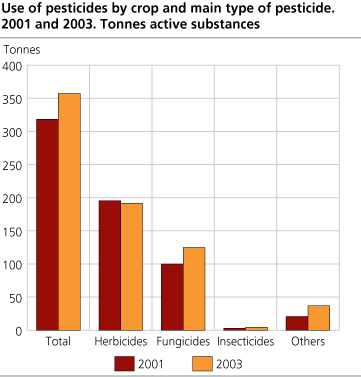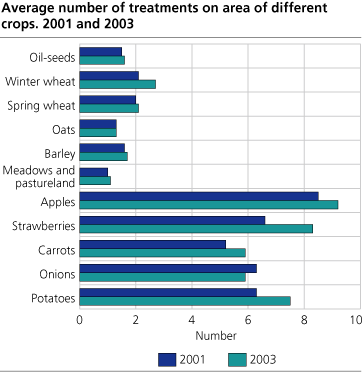Content
Published:
This is an archived release.
One third of agricultural area was sprayed
In 2003, only one third of the total agricultural area in use was sprayed with pesticides. The total use of pesticides in 2003 is estimated to 357 tonnes active substance. Spraying practice varies significantly among different crops.
Statistics Norway carried out a survey on pesticide use for the first time in 2001. Estimated as active substances, use of pesticides in agriculture has increased by 12 per cent from 2001 to 2003. Of the main types herbicides, fungicides, insecticides and other pesticides, herbicides constituted the main part of total pesticides used. In 2003, a total of 191.4 tonnes herbicides estimated as active substances were used in agriculture. The quantity of used herbicides was about the same in 2001. Probably, weather conditions caused increased use of fungicides and growth regulators. It is impossible to detect trends in pesticide use based on only two surveys. Nevertheless, weather conditions will significantly affect the use of pesticides. Several crops are afflicted with fungi in periods with humid and warm weather. This type of weather contributed to more spraying with fungicides in 2003 than two years ago, particularly in potatoes, strawberries, grains and oil-seeds. From 2001 to 2003, the total quantity of fungicides used increased by 25 per cent and is estimated to 124.6 tonnes active substance. In the same period, the quantity of so-called other pesticides also increased significantly. This group consists mainly of growth regulators that are used in grains to prevent lodged stands. Use of other pesticides as active substance increased from 20.4 tonnes in 2001 to 36.7 tonnes in 2003.
Small increase in treated area
In 2003, only one third of the total agricultural area in use was sprayed with pesticides. This is related to the fact that meadows and pastureland accounted for 63 per cent of the agricultural area in use, and only 6 per cent of meadows and pastureland were sprayed. For other crops, most of the area was treated at least once during the growing season. For potatoes, onions, carrots, strawberries, barley, oats and wheat, more than 90 per cent of the areas were treated. Furthermore, 87 per cent of the area of apple tree plantations and 76 per cent of the oil-seed area were treated with pesticides.
The percentage of total agricultural area sprayed at least once increased by 2 percentage points from 2001 to 2003. Among the crops included in the survey, only the percentage of treated apple tree plantation area decreased from 2001 to 2003.
Increasing number of treatments
The number of treatments varies significantly, both by crop and by size of crop area at the individual holding. For all crops, the number of treatments increased by size of crop area. An example; holdings with less than 0.5 hectares of potatoes sprayed in average 2.8 times, while holdings with at least 5 hectares sprayed 7.9 times. This is probably due to the fact that holdings with a large crop area are economically dependent on a good yield, both in quality and quantity, and use of pesticides will be an effort against failed yield.
The pressure from pests (weeds, fungi and insects) differs between crops. The average number of treatments varied between 1.1 times in meadows and pastureland to 9.2 times in apples. From 2001 to 2003, the number of treatments increased in all crops, except onions. The largest increase was registered in strawberries where the average number of treatments increased from 6.6 times in 2001 to 8.3 times in 2003.
Tables:
Contact
-
Berit Bjørlo
E-mail: berit.bjorlo@ssb.no
tel.: (+47) 40 81 13 76
-
Per Amund Aarstad
E-mail: per.amund.aarstad@ssb.no
tel.: (+47) 40 81 13 79


